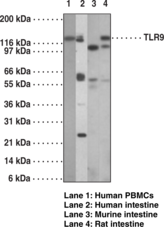| References |
| Synonyms |
|
| Formulation |
100 µg of protein G-purified IgG in 200 µl PBS containing 0.05% BSA and 0.05% sodium azide |
| Stability |
1 year |
| Storage |
-20°C |
| Shipping |
Wet ice
in continental US; may vary elsewhere
|
| Specificity |
| Canine TLR9 |
+ |
| Equine TLR9 |
+ |
| Murine TLR9 |
+ |
| Rat TLR9 |
+ |
| Rhesus monkey TLR9 |
+ |
Show all 5
Hide all but first 3
|
Background Reading
Hemmi, H., Takeuchi, O., Kawai, T., et al. A toll-like receptor recognizes bacterial DNA. Nature 408 740-745 (2000).
Gibson, F.C., Hong, C., Chou, H., et al. Innate immune recognition of invasive bacteria accelerates atherosclerosis in apolipoprotein E-deficient mice. Circulation 109 2801-2806 (2004).
Srivastava, M.D., and Srivastava, B.I.S. Expression of mRNA and proteins for toll-like receptors, associated molecules, defensins and LL-37 by SRIK-NKL, a CD8+ NK/T cell line. Leuk Res 7 813-820 (2005).
| Size |
Global Purchasing |
| 1 ea |
|
Description
Antigen:
human TLR9 amino acids 268-284
·
Clone designation:
26C593.2
·
Host:
Mouse
·
Isotype:
IgG1κ
·
Application(s):
WB, FC (intracellular and cell surface), IHC (frozen and paraffin-embedded sections), and ICC
·
The toll-like receptors (TLRs) in mammals comprise a family of transmembrane proteins characterized by multiple copies of leucine rich repeats in the extracellular domain and an interleukin-1 (IL-1) receptor motif in the cytoplasmic domain. Like their counterparts in Drosophila, TLRs signal through adaptor molecules.1 The TLR family is a phylogenetically conserved mediator of innate immunity that is essential for microbial recognition.2 Most mammalian species have between ten and fifteen types of TLRs. Ten functional TLRs (TLR1-10) have been identified in human. Humans also encode a TLR11 gene but it contains several stop codons and protein is not expressed. However, mouse and rat TLR11 are functional, and it is thought that human TLR11 function was lost during evolution. Historically speaking, TLR expression has been most extensively studied in the immune system. Overall, TLRs are highly expressed in immune competent cells, including macrophages, dendritic cells, neutrophils, mucosal epithelial cells and dermal endothelial cells. However, TLRs have also been identified in many other cell types and anatomical tissue locations where they are expressed either constitutively or induced during infection. Gene knockout experiments suggest that TLR9 acts as a receptor for unmethylated CpG dinucleotides in bacterial DNA.3 Human and murine TLR9 share an overall amino acid identity of 75.5%. TLR9 is highly expressed in spleen.
1
Srivastava, M.D., and Srivastava, B.I.S. Expression of mRNA and proteins for toll-like receptors, associated molecules, defensins and LL-37 by SRIK-NKL, a CD8+ NK/T cell line. Leuk Res 7 813-820 (2005).
2
Gibson, F.C., Hong, C., Chou, H., et al. Innate immune recognition of invasive bacteria accelerates atherosclerosis in apolipoprotein E-deficient mice. Circulation 109 2801-2806 (2004).
3
Hemmi, H., Takeuchi, O., Kawai, T., et al. A toll-like receptor recognizes bacterial DNA. Nature 408 740-745 (2000).
|






